Why should we read and hear Hindu Puranas stories | Why are Puranas important? | What do Puranas teach us? | What are the must read Puranas? | What is the value of the Puranas?
Namaste friends, how are you doing today? Welcome to #BhagavanBhakthi website / blog.
Bhagavan Lord Sri Krishna (Vishnu) (Rama) (Trivikrama) and Goddess Sri Rukmini Devi (Goddess Sri Lakshmi Devi) blessings to you and your family!
In this website / blog, you will always learn about #Hinduism #Sanskrit language.
Also subscribe to my YouTube channel from this link #BhagavanBhakthi to view videos about #Hinduism #Sanskrit language.
Just before moving towards to know about “Why should we read and hear Hindu Puranas stories | Why are Puranas important? | What do Puranas teach us? | What are the must read Puranas? | What is the value of the Puranas?“, let us know a brief, basic and very important information.
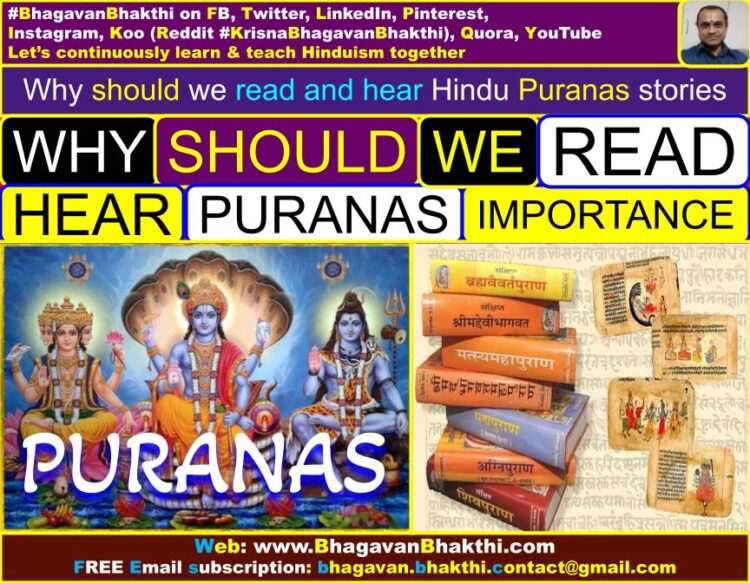
The meaning of the word Purana in Sanskrit is very old. Hindu Puranas contains the old tradition and history of our India (Bharat Varsha). Amarakosha, a Sanskrit dictionary says that Purana means a work with five features (Five Lakshanas).
सर्गश्च प्राति – सर्गश्च वंशे मन्वन्तराणि च | वंशानु चरितं चैव पुराणं पञ्च लक्षनम् ||
ಸರ್ಗಶ್ಚ ಪ್ರಾತಿ – ಸರ್ಗಶ್ಚ ವಂಶೇ ಮನ್ವಂತರಾಣಿ ಚ | ವಂಶಾನು ಚರಿತಂ ಚೈವ ಪುರಾಣಂ ಪಂಚ ಲಕ್ಷಣಂ ||
Sargaśca prāti – sargaśca vanśē manvantarāṇi ca | vanśānu caritaṁ caiva purāṇaṁ pan̄ca lakṣaṇaṁ ||
(1) Sarga – Primary creation. (2) Prati Sarga – Secondary creation. (3) Vamsha (Vansh) – Genealogy of Devatas (Demigods), Asuras (Demons), human beings etc. (4) Manvantara – Period of time and (5) Vamsanucharitam – History of Suryavansh (Suryavamsha) (Solar Dynasty) and Chandravansh (Chandravamsha) (Lunar Dynasty.
Apart from extolling the glories of the Supreme Lord Sri Vishnu, the Puranas also detail the sacrifices, bravery, greatness, mercy etc. of ancient kings, sages and great men. According to Matsya Purana they are very old compositions which are given below:
पुराणम् सर्व शास्त्राणम् प्रथमम् ब्राह्मण स्युथम्… | ಪುರಾಣಂ ಸರ್ವ ಶಾಸ್ತ್ರಾಣಂ ಪ್ರಥಮಂ ಬ್ರಾಹ್ಮಣ ಸ್ಯುತಂ… | Purāṇaṁ sarva śāstrāṇaṁ prathamaṁ brāhmaṇa syutaṁ…
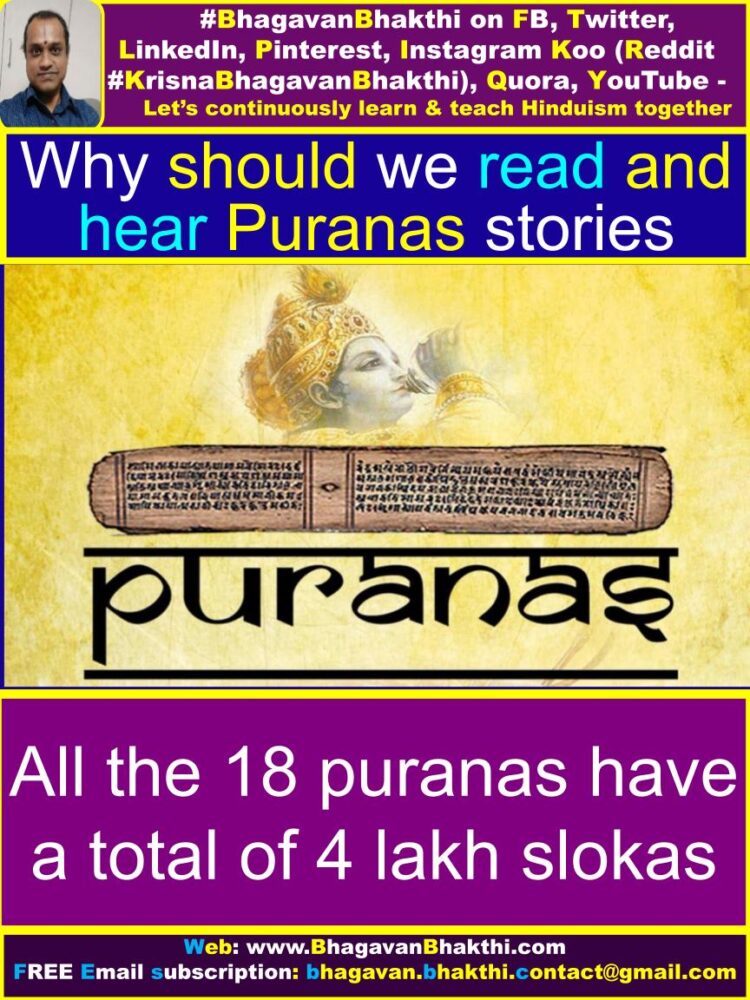
The Puranas contain crores of shlokas (verses) in one volume from previous Kalpas and Yugas. All the shlokas (verses) were condensed into 4 Lakh Shlokas (Slokas / hymns) by Lord (Sage) Sri Vedavyasa and divided into 18 Puranas, to be easily understood by everyone in Kali Yuga, the people of Kali Yuga are least knowledgeable human beings among all the Yugas.
पुराणमेकमेवासीत् तदा कल्पान्तरे किल | त्रिवर्ग साधनं पुण्यं शतकोटि प्रविस्तरं ||
तल्लक्षणं इदं प्रोक्तं व्यासेनाद्भुतं कर्मणा | अष्टदश पुराणानि कृत्वा सत्यवती सुतः || – पद्म पुराण – सृष्टि खण्ड
ಪುರಾಣಮೇಕಮೇವಾಸೀತ್ ತದಾ ಕಲ್ಪಾಂತರೇ ಕಿಲ | ತ್ರಿವರ್ಗ ಸಾಧನಂ ಪುಣ್ಯಂ ಶತಕೋಟಿ ಪ್ರವಿಸ್ತರಂ ||
ತಲ್ಲಕ್ಷಣಂ ಇದಂ ಪ್ರೋಕ್ತಂ ವ್ಯಾಸೇನಾದ್ಭುತ ಕರ್ಮಣಾ | ಅಷ್ಟದಶ ಪುರಾಣಾನಿ ಕೃತ್ವಾ ಸತ್ಯವತೀ ಸುತಃ || – ಪದ್ಮ ಪುರಾಣ – ಸೃಷ್ಟಿ ಖಂಡ
Purāṇamēkamēvāsīt tadā kalpāntarē kila | trivarga sādhanaṁ puṇyaṁ śatakōṭi pravistaraṁ ||
tallakṣaṇaṁ idaṁ prōktaṁ vyāsēnādbhuta karmaṇā | aṣṭadaśa purāṇāni kr̥tvā satyavatī sutaḥ || – Padma purāṇa – sr̥ṣṭi khaṇḍa
Padma Purana – srishti Khanda an ancient poem gives an easy way of remembering the names of Eighteen puranas.
‘म’ द्वयं, ‘भ’ द्वयं चैव भ्र त्रयं वा चतुष्ट्यम् | अ, न, प, लिम्, ग, कु, स्क-नि पुराणानि फ्रुथाक फ्रुथल् ||
‘ಮ’ ದ್ವಯಂ, ‘ಭ’ ದ್ವಯಂ ಚೈವ ಭ್ರ ತ್ರಯಂ ವಾ ಚತುಷ್ಟ್ಯಂ | ಅ, ನ, ಪ, ಲಿಂ, ಗ, ಕು, ಸ್ಕ-ನಿ ಪುರಾಣಾನಿ ಫೃಥಕ್ ಫೃಥಲ್ ||
‘Ma’ dvayaṁ, ‘bha’ dvayaṁ caiva bhra trayaṁ vā catuṣṭyaṁ | a, na, pa, liṁ, ga, ku, ska-ni purāṇāni phr̥thak phr̥thal ||
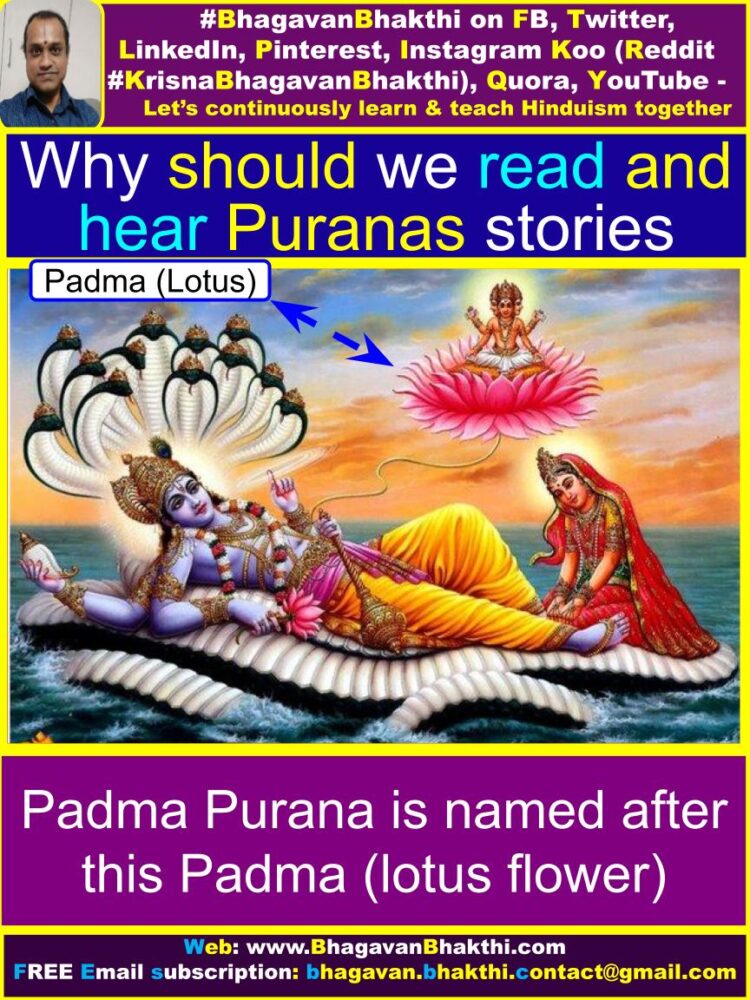
Meaning of the sloka : Two Puranas with “ma” as first letter – Matsya and Markandeya. | Two Puranas with “bha” as first letter – Bhagavata and Bhavishya. | Three Puranas with “bhra” as first letter – Brahma, Brahmanda and Brahmavairatha.
Four Puranas with “va” as first letter – Vamana, Vayu, Vishnu and Varaha. | One Purana with “a” as first letter – Agni | One Purana with “na” as first letter – Narada. | One Purana with “pa” as first letter – Padma. |
One Purana with “lim” as first letter – LiMga (Linga). | One Purana with “ga” as first letter – Garuda. | One Purana with “kU” as first letter – Kurma. | One Purana with “ska” as first letter – Skanda.
Of these Brahma and Padma puranas were first made available by the Devatas (Demigods) Guru (Teacher) Brihaspati. Padma Purana states that:
“ब्राह्मम् पुराणं प्रथमं दुतीयं पद्म-मुच्यते” || “ಬ್ರಾಹ್ಮಂ ಪುರಾಣಂ ಪ್ರಥಮಂ ದ್ವಿತೀಯಂ ಪದ್ಮ-ಮುಚ್ಯತೇ” || “Brāhmaṁ purāṇaṁ prathamaṁ dvitīyaṁ padma-mucyatē” ||
All the eighteen (18) Puranas are classified into Satvika, Rajasa and Tamasa Puranas. Those that extol the glory of Lord Sri Vishnu and uphold Lord Sri Vishnu’s ‘Sarvottamatva’ (Supremacy) are called as Satvika Puranas.

The classification can be seen from Padma Purana which states Brahma Purana, Padma Purna, Vishnu Purana are Satvika Puranas. Apart from these there are eighteen Upa Puranas (Sub Puranas) as given below:
सनतकुमार, नारसिंह, स्कान्द, शिवधर्मं, दौर्वास, कापिल, मानव, औशनस, वारुण, कालिक, साम्ब, नन्दिकृत, सौर, परशर, आदित्य, महेश्वर, वासिष्ठ और मरीच।
ಸನತಕುಮಾರ, ನಾರಸಿಂಹ, ಸ್ಕಾಂದ, ಶಿವಧರ್ಮ, ದೌರ್ವಾಸ, ಕಾಪಿಲ, ಮಾನವ, ಔಷನಸ, ವಾರುಣ, ಕಾಲಿಕ, ಸಾಂಬ, ನಾಂದಿಕೃತ, ಸೌರ, ಪರಾಶರ, ಆದಿತ್ಯ, ಮಹೇಶ್ವರ, ವಾಸಿಷ್ಠ ಮತ್ತು ಮಾರಿಚ.
Sanatakumāra, nārasinha, skānda, śivadharma, daurvāsa, kāpila, mānava, auṣanasa, vāruṇa, kālika, sāmba, nāndikr̥ta, saura, parāśara, āditya, mahēśvara, vāsiṣṭha and mārica.
Of course there are variations in the names of Upa Puranas as listed in Devi Bhagavatam and as in Smriti Muktavali. Some Scholars are of opinion that those compiled by Lord (Sage) Sri Vedavyasa are called by the names of Puranas and those by other rishis are Upa Puranas.
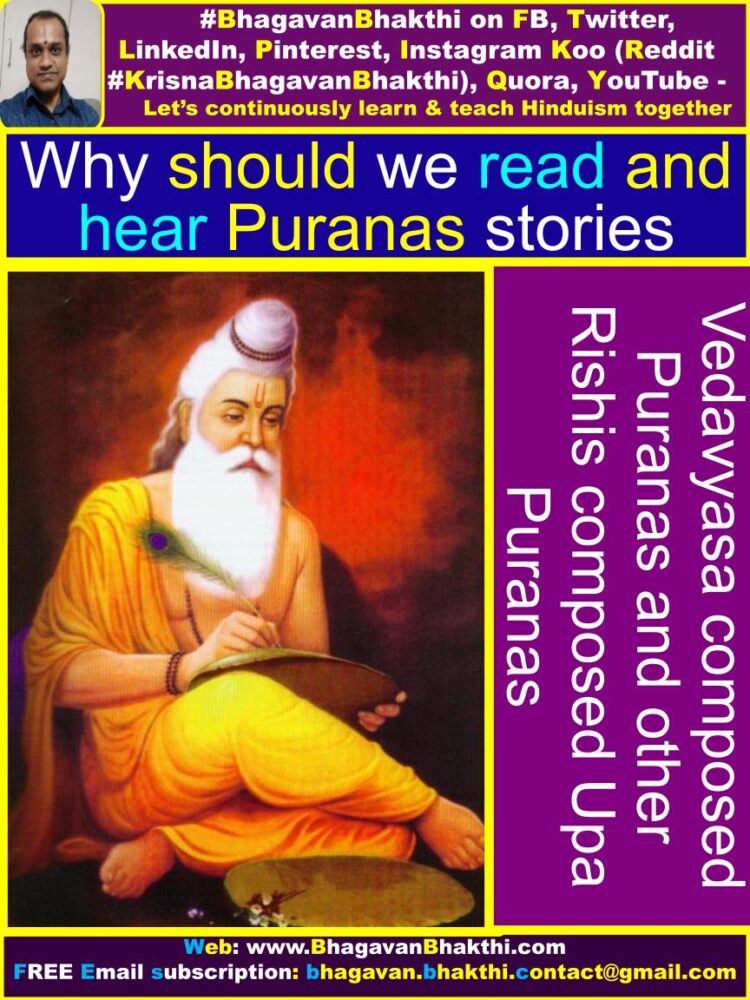
Of the Eighteen major Puranas, ‘Vishnu Purana’ is an important Purana as can be seen from the following authorities.
1. Parashara Purana, one of the Upa Purana states that:
सात्विकानि पुराणनि श्रेयांसि निकिलान्यपि | तत्र भागवतं श्रेष्ठं ततो वैष्णवमुत्तमम् || ಸಾತ್ವಿಕಾನಿ ಪುರಾಣಾನಿ ಶ್ರೇಯಾಂಸಿ ನಿಕಿಲಾನ್ಯಪಿ | ತತ್ರ ಭಾಗವತಂ ಶ್ರೇಷ್ಠಂ ತತೋ ವೈಷ್ಣವಮುತ್ತಮಂ || Sātvikāni purāṇāni śrēyānsi nikilān’yapi | tatra bhāgavataṁ śrēṣṭhaṁ tatō vaiṣṇavamuttamaṁ ||
Meaning of the sloka : All the Satvika Puranas are conducive to eternal welfare. Of them Bhagavata purana is the best. But there is better one than this and it is “Vishnu Purana”.
पुराणं एतत् सदृशं न हि अन्यदुपपध्यते | आदौ मध्ये तथान्ते च गीथतेत्र हरिर्भुहुः || ಪುರಾಣಂ ಏತತ್ ಸದೃಶಂ ನ ಹಿ ಅನ್ಯದುಪಪಧ್ಯತೇ | ಆದೌ ಮಧ್ಯೇ ತಥಾಂತೇ ಚ ಗೀಯತೇತ್ರ ಹರಿರ್ಭೂಹುಃ || Purāṇaṁ ētat sadr̥śaṁ na hi an’yadupapadhyatē | ādau madhyē tathāntē ca gīyatētra harirbhūhuḥ ||
Meaning of the sloka : There is no other Purana equal to it, since the supreme Lord Sri Vishnu forms its subject matter throughout, that is, in the beginning, in the middle and at the end too.
षडक्षर स्वरूपास्ते ये शडशाः प्रकीर्तितः | शड-गयोग-दुष्प्रापं प्रयच्छान्ति गतीं ऋणां || ಷಡಕ್ಷರ ಸ್ವರೂಪಾಸ್ತೆ ಯೆ ಷಡಶಾಃ ಪ್ರಕೀರ್ತಿತಃ | ಶಡ-ಗಯೋಗ-ದುಷ್ಪ್ರಾಪಂ ಪ್ರಯಚ್ಛಾಂತಿ ಗತೀಂ ಋಣಾಂ || Ṣaḍakṣara svarūpāste ye ṣaḍaśāḥ prakīrtitaḥ | śaḍa-gayōga-duṣprāpaṁ prayacchānti gatīṁ r̥ṇāṁ ||
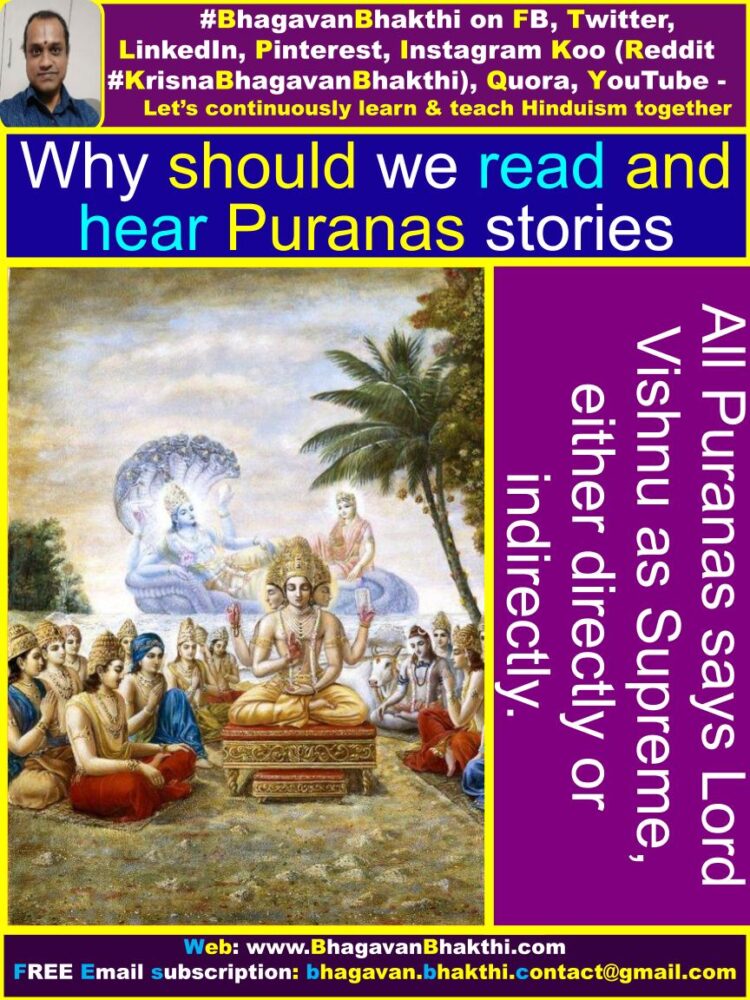
Meaning of the sloka : The six points narrated here have expositions of the six letters of “shadakshara Mantra” (Om Vishnave Namaha) and this will lead to blissfulness which even the six angas of the Vedas fail to secure.
2. Garuda Purana: वेदेषु पौरुषं सूक्तं धर्म शास्त्रेषु मानवं | भारते भगवद्गीताः पुराणेषु च वैष्णवम् || ವೇದೇಷು ಪೌರುಷಂ ಸೂಕ್ತಂ ಧರ್ಮ ಶಾಸ್ತ್ರೇಷು ಮಾನವಂ | ಭಾರತೇ ಭಗವದ್ಗೀತಾಃ ಪುರಾಣೇಷು ಚ ವೈಷ್ಣವಂ || Vēdēṣu pauruṣaṁ sūktaṁ dharma śāstrēṣu mānavaṁ | bhāratē bhagavadgītāḥ purāṇēṣu ca vaiṣṇavaṁ ||
Meaning of the sloka : Of the Vedas, Purusha Sukta, Dharma Shastras, Manu Smriti, Bhagavad Gita, Mahabarata – Vishnu Purana contains the essence of all these.
3. The Linga purana extols Vishnu Purana as Sarvavedartena Samyutham, that is, Linga Purana places Vishnu Purana in the same Level as Vedas.
4. Founders of the three school of Vedanta quote from it in their Bhasyas (commentaries).
5. The Naradiya Purana in the course of dialogue between Brahma and Marichi says that: ब्रह्नोवाच (ಬ್ರಹ್ಮೋವಾಚ) (Brahmōvāca) (As said by Lord Sri Brahma) –
श्रुणु वत्स प्रवक्ष्यामि पुराणं वैष्णवं महूत् | त्रयो विंशति सहस्रं सर्व – पातक नशनं || ಶ್ರುಣು ವತ್ಸ ಪ್ರವಕ್ಷ್ಯಾಮಿ ಪುರಾಣಂ ವೈಷ್ಣವಂ ಮಹೂತ್ | ತ್ರಯೋ ವಿಂಶತಿ ಸಹಸ್ರಂ ಸರ್ವ – ಪಾತಕ ನಾಶನಂ || Śruṇu vatsa pravakṣyāmi purāṇaṁ vaiṣṇavaṁ mahūt | trayō vinśati sahasraṁ sarva – pātaka nāśanaṁ ||
Meaning of the sloka : Lord Sri Brahma says – Listen to me my son, the great ‘Vishnu Purana’ given out in 23,000 slokas (verses) is the purifier of all the sins.

More information : The sage Sanatakumara is Lord Sri Brahma’s Manasa putra (child born from the mind) (Sanatakumara is among the four Sanata Kumaras. All these four Sanata Kumaras’ age will always remain at 5 years until the end of the Maha Kalpa).
Once Sanatakumara had gone to visit Lord Sri Yama, the god of death. While Sanatakumara and Lord Sri Yama were conversing with each other, a shining vimana / airplane brought a man towards Lord Sri Yama who immediately stood up to honor the guest.
Lord Sri Yama worshipped him and said, “I am honored. I hope you had no problems on the way. The vimana / airplane will take you to Lord Sri Brahma’s residence in Brahmaloka”.
After this guest had left, another shining vimana / airplane brought another guest who was also worshipped in similar fashion by Lord Sri Yama. Sanatakumara was mystified at this and he asked Lord Sri Yama, “Who are these two people? I have never heard of Lord Sri Yama worshipping anyone in such glowing terms”.
Sanatakumara continued, “These two must be really holy men indeed. They must have accumulated a lot of punya (good deeds). Who are they? Tell me their stories”.
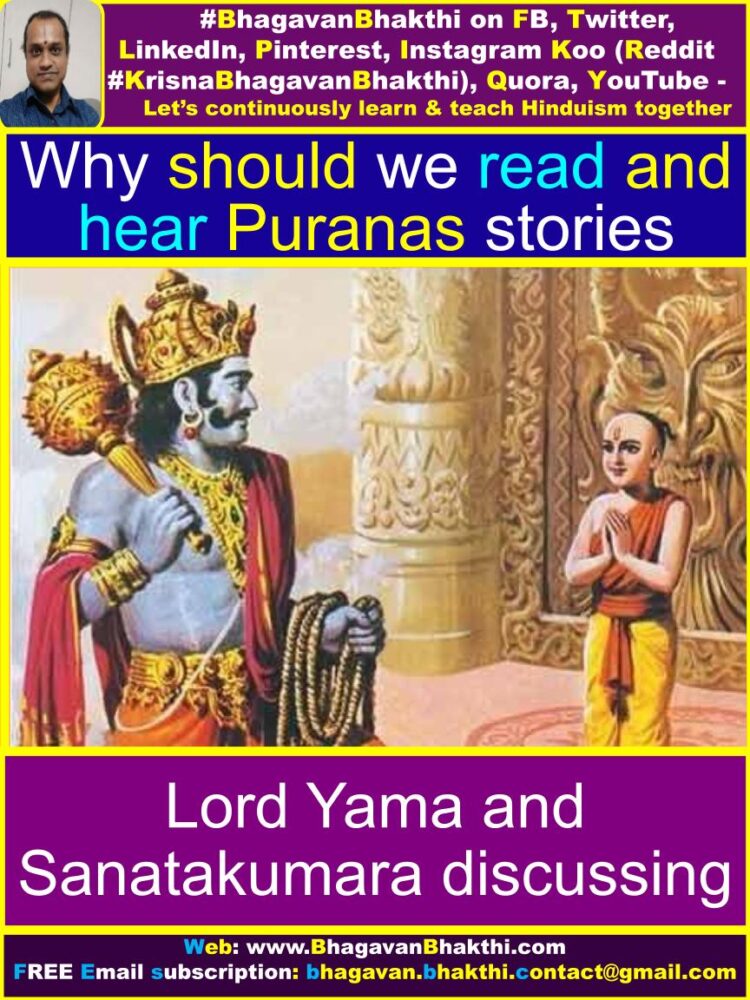
Lord Sri Yama obliged and told the following story to Sanatakumara: There was a city named Vaidisha. The king who ruled there was named Dharapala. Nandi was cursed by Goddess Sri Parvati Devi that he would have to spend twelve years on earth as a jackal.
Nandi’s crime was that, when Goddess Sri Parvati Devi had gone to perform tapasya / penance, Nandi had permitted a false Parvati to enter Lord Shiva’s palace. Thus Nandi was born as a jackal. This jackal went to the confluence of the rivers Vitasta and Vetravati.
There it set up a Linga and prayed before it, going without food and water. After the twelve years passed, the jackal died and adopted a shining form. In this form, Nandi returned to Shiva Loka (Kailash). King Dharapala had seen the jackal fasting and praying. He also witnessed its strange death.
The King Dharpals’s wonder knew no bounds. He erected a temple in that wonderful place. King Dharapala brought several Brahmanas (Brahmins) to the temple and made them recite the Puranas there.
When King Dharapala died, it was decided that he would go to Brahma Loka (Satya Loka) because of all this punya (good deeds). This was the first guest who had come before Lord Sri Yama. Such are the wonderful virtues of worshipping Lord Shiva and the Puranas.
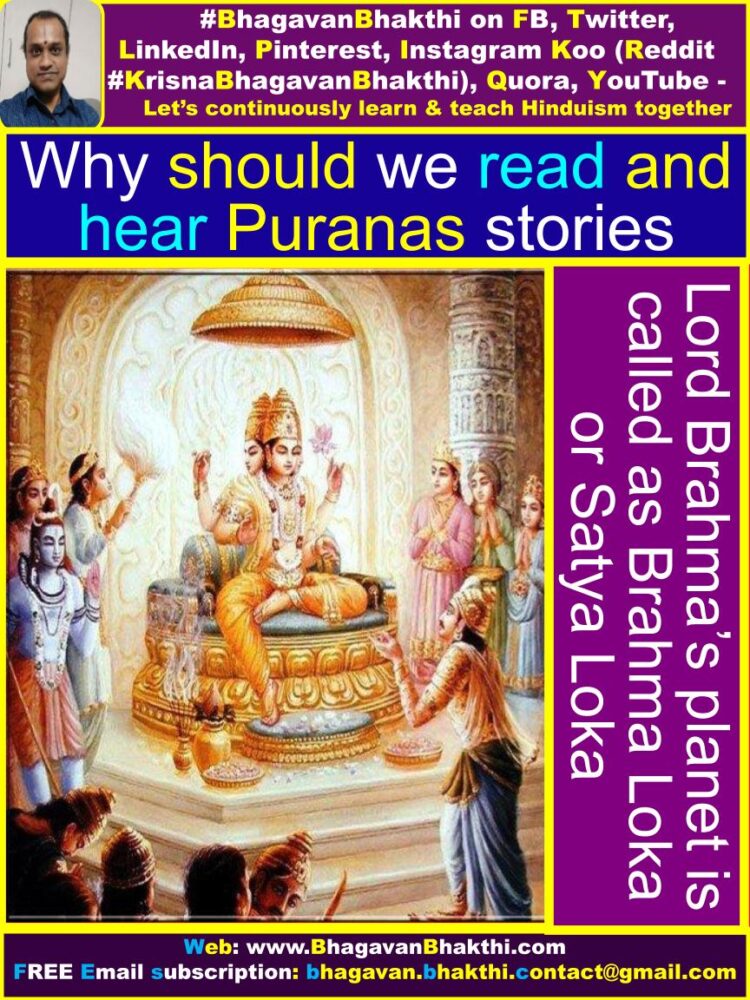
“What about the second guest?” asked Sanatakumara to Lord Sri Yama. The second guest used to be evil. He had never donated anything in his life. But he once heard the Puranas being recited and was completely converted.
He arranged many recitals of the Puranas on his own and donated gold to the reciters later. This punya (good deeds) was going to take him to Brahma Loka (Satya Loka). Such are the wonderful virtues of hearing and reading the Puranas.
Doing this is tantamount to worshipping Lord Sri Brahma, Bhagavan Lord Sri Vishnu and Lord Shiva.
PS: We always remember that Lord Sri Brahma is the son of Bhagavan Lord Sri Vishnu. And whereas Lord Shiva is the son of Lord Sri Brahma Deva. Thus the Sarvottama / Supreme among all is Bhagavan Lord Sri Vishnu / Sri Rama / Sri Krishna.
All, including Goddess Sri Maha Lakshmi Devi, Lord Sri Brahma Deva, Goddess Sri Sarasvati Devi, Lord Sri Rudra Deva (Lord Shiva), Goddess Sri Tulasi Devi, Goddess Sri Parvati Devi, Lord Sri Indra Deva, Lord Sri Surya Deva etc. are all followers of Bhagavan Lord Sri Vishnu.

The 18 Mahapuranas have four lakh shlokas all together and their names are as follows:
1. The Brahma Purana: This was originally recited by Brahma to the sage Marichi and has thirteen thousand shlokas.
This text should be donated on a full moon night (purnima) in the month of Vaishakha. Such a donation brings undying punya.
2. The Padma Purana: This has fifty-five thousand shlokas and should be donated in the month of Jyaishtha.
3. The Vishnu Purana: This was first recited by the sage Parashara and has twenty-three thousand shlokas. It is auspicious to donate this text in the month of Ashada.
4. The Vayu Purana: This has twenty-four thousand shlokas and was first recited by the wind-god Vayu. It should be donated in the month of Shravana.
5. The Bhagavata Purana: This has eighteen thousand shlokas and should be donated in the month of Bhadra, on the night of the full moon.
6. The Narada Purana: This was first recited by the sage Narada and has twenty-five thousand shlokas. It should be donated on the night of the new moon (amavasya) in the month of Ashvina.
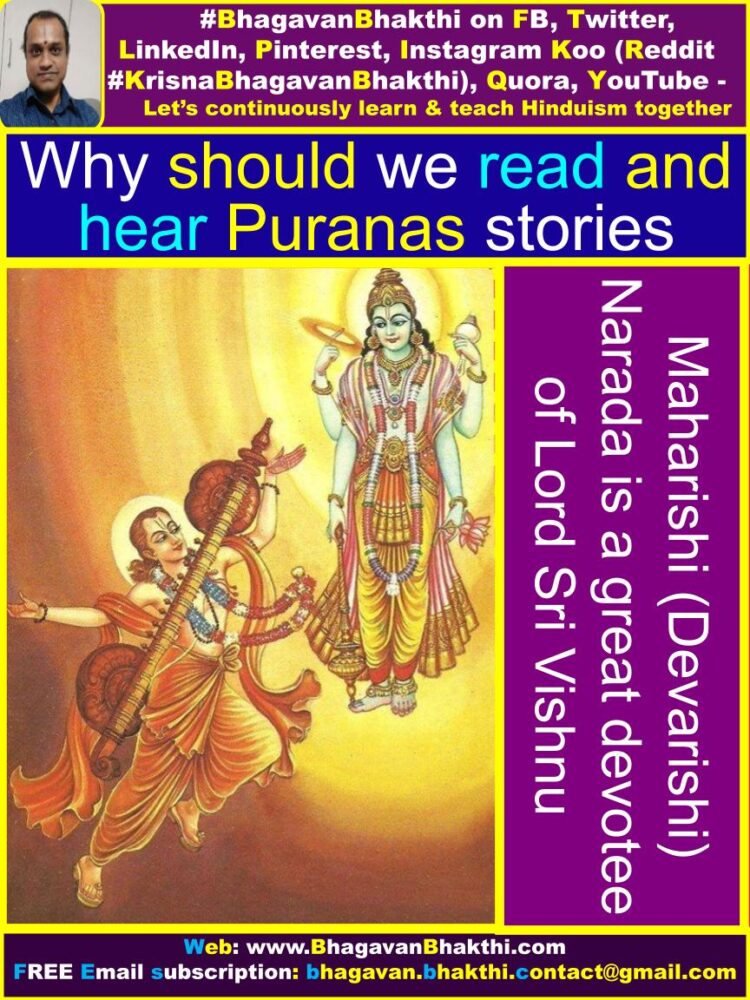
7. The Markandeya Purana: This has nine thousand shlokas. A person desirous of obtaining punya should donate this text in month of Margashirsa.
8. The Agni Purana: This was first recited by the fire-god Agni to the sage Vashishtha. It has sixteen thousand shlokas and should be donated in the month of Margashirsha.
9. The Bhavishya Purana: Brahma himself was the first reciter of this Purana and it has fourteen thousand and five hundred shlokas. It is primarily concerned with what is due to happen in the future. The text should be donated on the occasion of purnima, in the month of Pousha.
10. The Brahmavaivarta Purana: This was first recited by Savarni Manu to the sage Narada. It has eighteen thousand shlokas and should be donated on purnima in the month of Magha.
11. The Linga Purana: Brahma recited this first and it has eleven thousand sholkas. Punya is acquired if this text is donated in the month of Falguna.
12. The Varaha Purana: The great Vishnu first recited this to the earth. It has twenty-four thousand shlokas and is to be donated in the month of Chaitra.
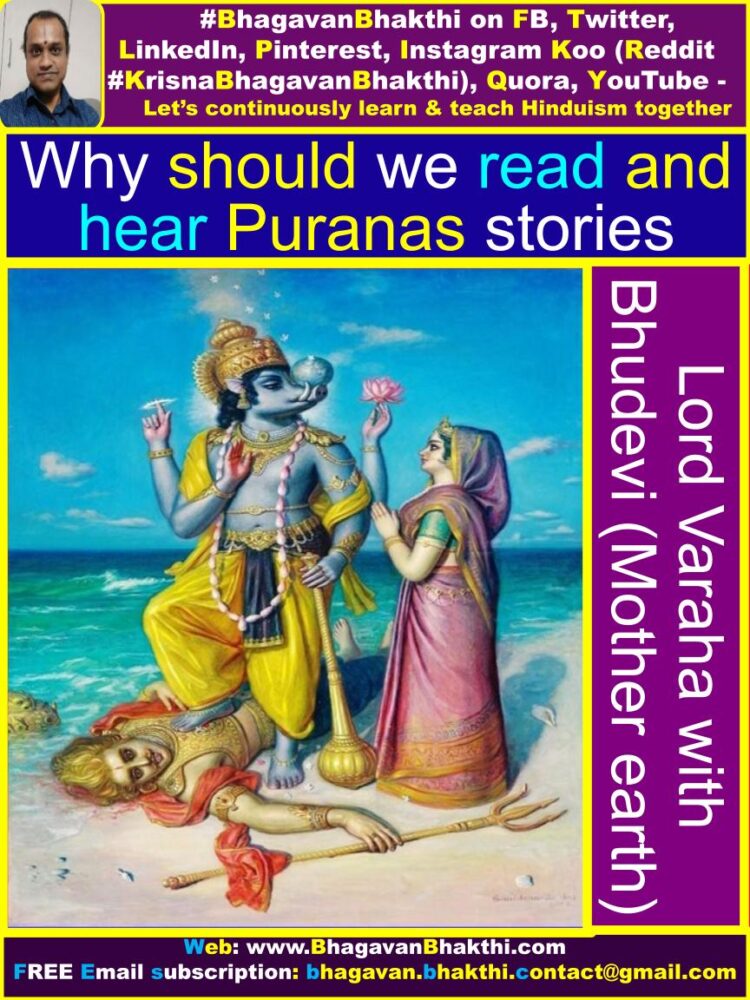
13. The Skanda Purana: This was composed by the god Skanda or Kartikeya. It has eighty-one thousand shlokas and one desirous of punya donates the text in the month of Chaitra.
14. The Vamana Purana: Brahma was the first person to recite this. It has ten thousand shlokas and the text should be donated in early autumn (sharat).
15. The Kurma Purana: Vishnu recited this in his form of a turtle. It has eighteen thousand shlokas and should be donated at the time of the equinoxes.
16. The Matsya Purana: Vishnu recited this in his form of a fish to Manu. It has fourteen thousand shlokas and should be donated at the time of the equinoxes.
17. The Garuda Purana: Krishna was the first person to recite this and it has eighteen thousand shlokas. (When this text is to be donated is not stated.)
18. The Brahmanda Purana: Brahma recited this and it has twelve thousand and two hundred shlokas.
My dear friends please note that, these Puranas are merely for human consumption. Much longer versions are read by the Devatas (Demigods) in the higher planets. The total number of shlokas in the Puranas that the Devatas (Demigods) read is one hundred crores.

Continue reading more information about Hindu Puranas from here : Information and significance of Hindu Puranas.
More information will be added to this on regular, please visit after some time to know more information.
To watch videos on #Hinduism #Sanskrit language, SUBSCRIBE to my YouTube channel from this below link:
#BhagavanBhakthi YouTube channel
To know about “Ekadashi unknown facts” and real significances of Ekadashi fasting, kindly click the below link:
To know more about “Lord Krishna unknown facts“, please click the below link:
To know more about “Lord Vishnu unknown facts“, please click the below link:
To know more about “Lord Shiva unknown facts“, please click the below link:
Dear friends, if you need any clarifications about this post, kindly let me know, I will definitely try to answer all of them.
Also your one LIKE, one COMMENT, One Share, one SUBSCRIPTION is highly important.
This will help to know the quality of this content and also it will be helpful to know if any improvements is required for the content.
If you feel this content is useful to you and has helped you to improve your knowledge, kindly share this with your well-wishers.
Because “SHARING MEANS CARING”.
For receive FREE EMAIL SUBSCRIPTION about #BhagavanBhakthi, you can send an email to [email protected] from your email ID.
NAMASTE!
Sri Gurubhyo Namaha
OM NAMO NARAYANAYA
Sri Krishnaarpanamastu